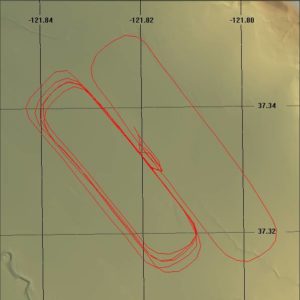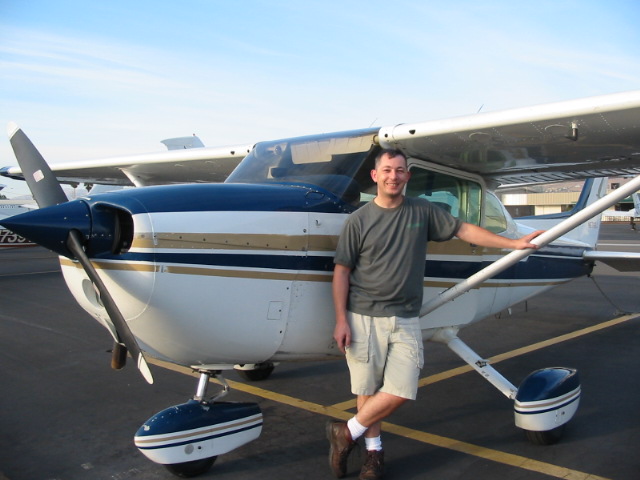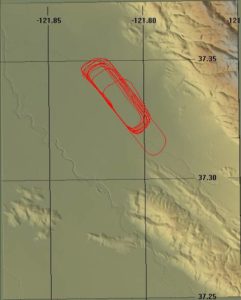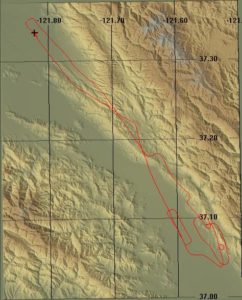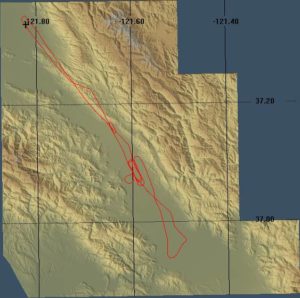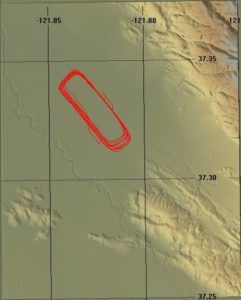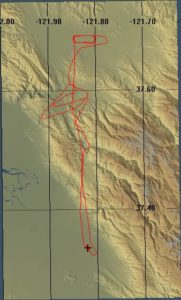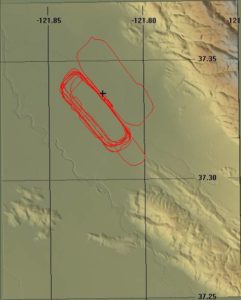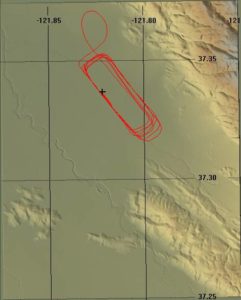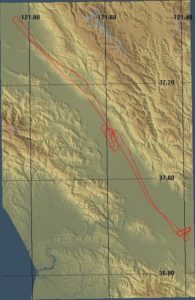 Today was a really nice flight. The weather was good with variable winds at 5 knots in RHV, some scattered clouds at 20,000’ and it was warm at 27C, a little hazy with 10 miles visibility. I was early, and Grainne turned up about 2:45pm. We went over today’s plan. A flight down to Hollister (3O7) to do some solo landings and pattern work, and then a stop off in South County (Q99) for the same. We would also try to get flight following from Bay Approach along the way to see how that worked. Flight following is where you ask Air Traffic Control to issue you with traffic alerts using their radar, which they provide if they aren’t too busy.
Today was a really nice flight. The weather was good with variable winds at 5 knots in RHV, some scattered clouds at 20,000’ and it was warm at 27C, a little hazy with 10 miles visibility. I was early, and Grainne turned up about 2:45pm. We went over today’s plan. A flight down to Hollister (3O7) to do some solo landings and pattern work, and then a stop off in South County (Q99) for the same. We would also try to get flight following from Bay Approach along the way to see how that worked. Flight following is where you ask Air Traffic Control to issue you with traffic alerts using their radar, which they provide if they aren’t too busy.
Normal pre-flight, taxi, run-up and take off on 31L with a downwind departure from left traffic. I took off behind a Cessna 152 and followed him South, as I was a bit faster and climbed a bit better we gradually overtook him, he was the only traffic we encountered until Anderson Reservoir. Grainne, tuned into Bay Approach and after initially telling us to stand by, they gave us a transponder code to squawk and started issuing traffic warnings, none of which were much use. Firstly, they never told us about the C152 1000’ below us, and then over Anderson Reservoir another Cessna 172 flew right passed us only 500’ above our altitude. They did however tell us all about the big jets on final approach to San Jose International, none of which were anywhere close to us. However, it was still cool flying along hearing your own plane’s call sign and also listening to all the big planes getting their approach clearances into San Jose. Bay Approach terminated flight following about 12 miles North of Hollister, we had expected them to pass us off to Monterey Approach, but they just told us to squawk 1200, the VFR transponder code, meaning we were back on our own.
I tuned into the Hollister CTAF frequency about 10 miles North of the field and asked for a traffic advisory, one plane replied that he had just taken off into a stiff headwind from runway 24, which is the shorter of the two runways. I had spent some time before hand working out the traffic patterns for the airport as this was my first visit down here, we took a quick review as I started to descend from 3500’. About this time another plane called in from Southeast of the field looking for a traffic advisory, so I passed on the info I’d just got. He said he was just doing a touch and go and entered the left 45 as I crossed the field at 2000’. I did a descending right 270 degree turn which brought me in on the 45 for left downwind. One of the more complicated pattern entries but it worked beautifully. The other plane was just turning base as I entered the downwind and he was already departing when I got onto final. The headwind was really blowing, I kept checking my airspeed which was 65~70 KIAS on short final, but we still seemed to just crawl towards the numbers. I would guess the wind was at l2~15 knots, but at least it didn’t appear to be gusting. The landing was reasonable. I cleared the runway and dropped Grainne off by some hangers. Then taxied off to do two solo landings. These went reasonably well, but the pattern was a bit sloppy, especially trying to keep parallel to the runway. It didn’t feel too bad at the time, but the GPS shows I was angling in towards the runway on both downwind trips. This shortened the base leg, which pretty much made them continuous turns instead of two turns. Another plane landed as I flew the second trip through the pattern. He pretty much just came straight in for the runway. I don’t think your supposed to do this, but at least he told me what he was up to so it wasn’t a surprise. The first landing was good, on the second I ballooned up and had to add some power to keep from dropping back in. I think it looked better from the ground than it did from the plane because Grainne didn‘t seem that upset when I taxied back to pick her up. We took off and made a right crosswind departure, it was real bumpy as I climbed back up to 3000’
Once we got back to cruise altitude Grainne told me it was my choice if I wanted to go to South County, I guess she thought I might be tired, I felt fine so I tuned in South County CTAF and started a descent. There was one plane on the ground saying he had just landed on runway 32, so I planned to fly wide of the field and then make a left turn onto the 45 for right downwind. The pattern entry was good, but something wild happened to the turn onto base. I came out almost passed the end of the runway and so overshoot badly on the turn to final. Then I overcompensated trying to get lined up for final. At this stage I figured this approach was so screwed up I’d just go around and try it again. I really wasn’t sure what had gone wrong, I’ve flown the pattern several times before without problems. I had just climbed back to pattern altitude of 1300’ and made the turn onto crosswind when some guy came on the radio and said he was the FBO (Fixed Base Operator) and that the wind sock was now showing the wind favored runway 14. I was flying the downwind for 32 at this point so I was a little lost as to what to do. I figured I’d take a look at the windsock for myself and then decide. So I said on radio I was going to fly parallel the runway and take a look at the windsock, to which the FBO guy replied, “I can see it from where I’m sitting and it favors 14”, he sounded kind of mad that I didn’t believe him or something. But he’s on the ground and I’m in the plane so I’ll be the one who decides which f**king runway I’m going to land on. The windsock did favor 14 so I made a left 180 degree turn and came in on a very long base leg. The landing was reasonable, and we did the touch and go. Grainne said we’d do a downwind departure and head back for home. There was more interesting radio work on the way out, another plane was coming in from the South, and it was a comedy of errors while he tried to determine what planes were flying, instead of listening to what people were saying he kept asking where people were. Along the lines of “where is the plane in the air?” (I hope he knew there was only one) and “who is still on the ground?”.
I had a pretty uneventful trip back to RHV. Called the tower at 3000’ over UTC and was told to come straight in for 31L. Started a nice stable 90 KIAS descent and the approach went well, though I got changed to 31R at the 3 mile report point. I added the full flaps a little early and so had to add some power coming over the Mall. I even tried a little side slip to account for the minor crosswind (I had too much rudder, but any practice is welcome). The landing bounced once, but recovered in a reasonable fashion – not good though.
So today was fun, a new airport, more solo work that’s really not scary now and some real interesting pattern work at uncontrolled airports. Now I’m endorsed for both Hollister and South County so I have the run of the south practice area on my own. On Wednesday I’ll do an hour of ground work to plan the first cross country flight with Grainne, and we’ll fly it on Saturday. I’ve also signed up for some solo flights on Thursday and Sunday so I’ll head down south and practice some maneuvers and landings.

